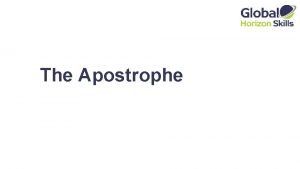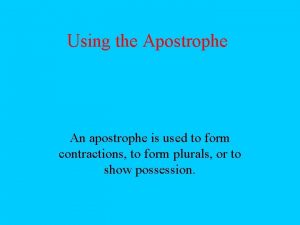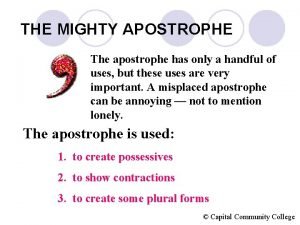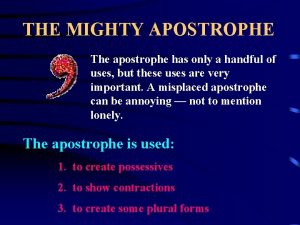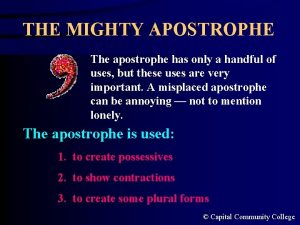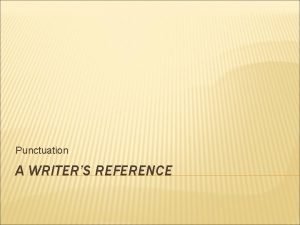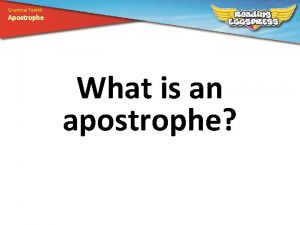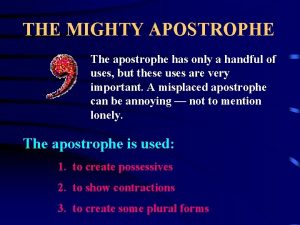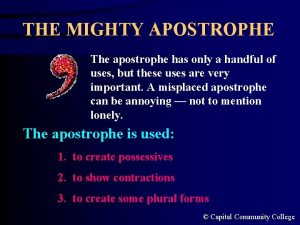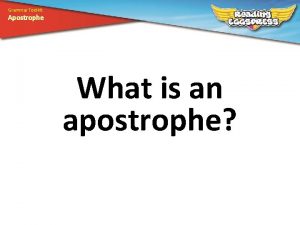APOSTROPHE Usage The apostrophe is used 1 to











- Slides: 11

APOSTROPHE Usage The apostrophe is used: 1. to create possessives / show ownership - Singular possessives ‘s - Plural possessives s’ 2. to create contractions (omitted letters) 3. To form the plural for digits and letters It is NOT used to show that a word is plural. (to show that there is more than one of something) © Capital Community College

APOSTROPHE Usage The apostrophe is used to create possessive forms for singular and plural nouns, especially nouns referring to people. the mayor’s car, my father’s moustache Pedrito’s sister, Joe Kennedy’s habits © Capital Community College

APOSTROPHE Usage When a noun already ends in “s, ” you can decide whether or not to use another “s” after the apostrophe. Charles’s car OR Charles’ car Typically, it is best just to add an apostrophe after the s if the word ends in s. Dumas’ second novel, Jesus’ birth, Socrates’ ideas, Illinois’ legislature © Capital Community College

APOSTROPHE Usage If you are using the phrase “of the…” a lot, it can be clunky and wordy. Try using an apostrophe for smoother writing. The roar of the crowd, the pride of this character a year’s salary, my heart’s desire, your dollar’s worth, the paper’s conclusion © Capital Community College

APOSTROPHE Usage To form the possessive of a plural noun, we pluralize first and then add the apostrophe. The Kennedys’ house The children’s playhouse The travelers’ expectations Notice that with an irregular plural, the apostrophe will come before the “s. ” © Capital Community College

IRREGULAR plurals With an irregular plural, the word is plural but the apostrophe comes BEFORE the s. This is unusual because we are used to thinking that ‘s means the word is singular. The face of the child The child’s face (singular) The backpacks of the children The children’s backpacks (plural – children indicates more than one child) © Capital Community College

APOSTROPHE Use A contraction allows us to blend sounds by omitting letters from a verb construction. The apostrophe shows where something is left out. I am a student here = I’m a student here. I have been working on the railroad. = I’ve been working on the railroad. They could have been great together. = They could’ve been great together. © Capital Community College

It’s – How do I use it? It’s is a contraction for “it is. ” You know if you are using it correctly because you can substitute “it is” to see if it fits properly: It’s a nice day out. – It is a nice day out. (correct) The dog wagged it’s tail. – The dog wagged it is tail. (incorrect) © Capital Community College

Its – How do I use it? Its (no apostrophe) is used to show possession or ownership. The dog wagged its tail (the tail belongs to the dog). The couch was replaced because its stuffing was ripping out. (the stuffing belongs to the couch) © Capital Community College

APOSTROPHE Usage The apostrophe is also used to form the plural of digits and letters. . . The word Mississippi has four s’s. She got three A’s and two B’s last semester. She dotted all her i’s very carefully. . and to indicate omission of a number in a date: summer of ’ 99; class of ’ 38 © Capital Community College

This Power. Point presentation was created by Charles Darling, Ph. D Professor of English and Webmaster Capital Community College Hartford, Connecticut copyright November 1999 © Capital Community College
 Apostrophe at the end of a word
Apostrophe at the end of a word Thế nào là mạng điện lắp đặt kiểu nổi
Thế nào là mạng điện lắp đặt kiểu nổi Cách giải mật thư tọa độ
Cách giải mật thư tọa độ Lời thề hippocrates
Lời thề hippocrates Vẽ hình chiếu đứng bằng cạnh của vật thể
Vẽ hình chiếu đứng bằng cạnh của vật thể Chụp phim tư thế worms-breton
Chụp phim tư thế worms-breton Quá trình desamine hóa có thể tạo ra
Quá trình desamine hóa có thể tạo ra Khi nào hổ con có thể sống độc lập
Khi nào hổ con có thể sống độc lập điện thế nghỉ
điện thế nghỉ Các châu lục và đại dương trên thế giới
Các châu lục và đại dương trên thế giới Dạng đột biến một nhiễm là
Dạng đột biến một nhiễm là Nguyên nhân của sự mỏi cơ sinh 8
Nguyên nhân của sự mỏi cơ sinh 8
